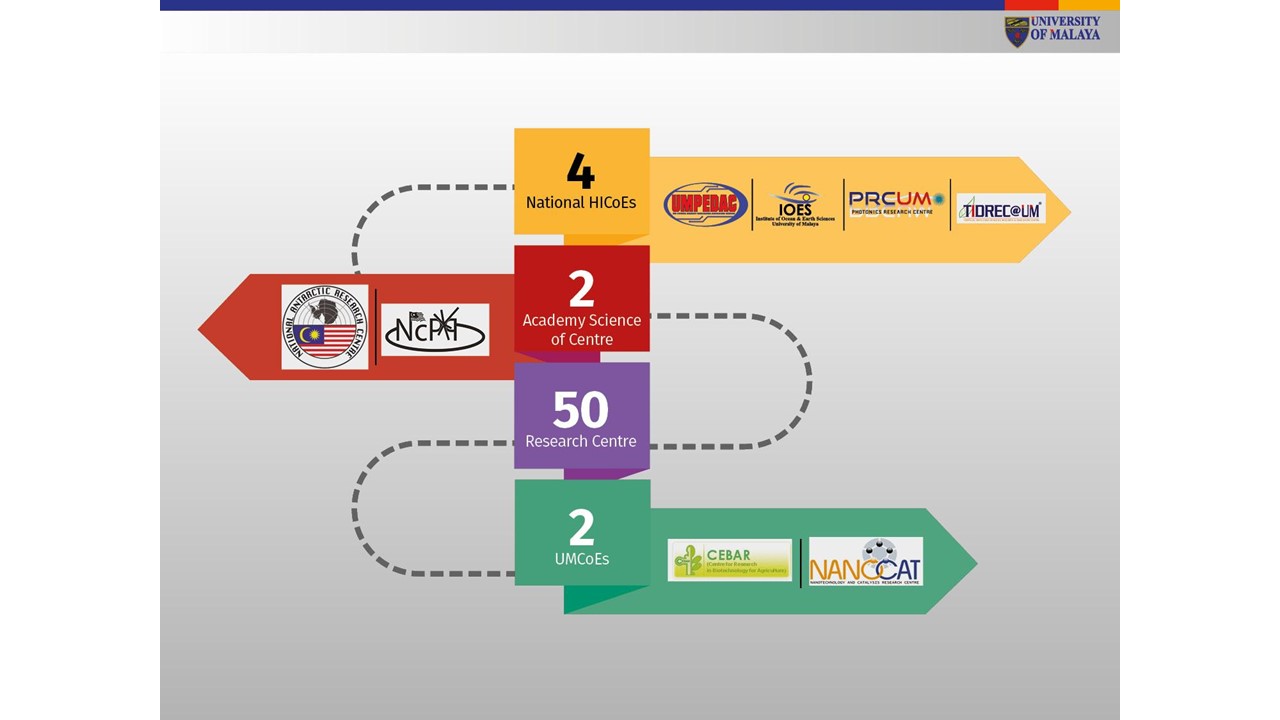
History
In support to the third thrust of National Higher Education Strategic Plan (NHESP) and moving towards gearing up the level of the countrys research and development (R&D) and innovation, the Ministry of Higher Education (MoHE) finds that there is a need to recognise the potential centres of excellence (CoEs) in Higher Education Institutions (HEIs) in order to further leap them towards internationalisation. The recognition of HICoE by MOHE is to indentify best of the best CoE in HEIs at national level.
The first evaluation exercise of HICoE was undertaken in 2008. From 142 applications, 6 CoEs in 5 public HEIs met the stringent requirements. With the approval of the Cabinet and on the recommendation of MoHE, the approved CoEs were formally designated to be HICoE on 30th October 2009. The efforts of identifying and acknowledging the achievement of CoEs in HEIs will encourage them to work towards becoming a global leader in their research niche areas. Thus, HICoE will be supported and facilitated by MoHE so that they will become the focused vehicles that will drive R&D and innovation agenda particularly in fundamental research, as well as contributing to human capital development.
Overview
In 2000, UMPEDAC was set up by a small group of researchers as Centre of Research for Power Electronics, Automation, Control, and Communications. In 2004, this research centre was officially established under the Centre for Research of the Faculty of Engineering (CReFE) as University of Malaya’s Power Electronics, Drives, Automation, and Control Centre. In conjunction with the development of the niche, experts and infrastructures, on 28 July 2011, the name was again changed to UM Power Energy Dedicated Advanced Centre, retaining the UMPEDAC acronym.
Overview
Photonics research made its debut in the University of Malaya with the construction of the University very first laser in 1979. Under the guidance of Prof Dr. Harith Ahmad ,the laboratory ventured outward, further expanding the research activities of the Photonics Laboratory to encompass not only lasers but also fiber optic devices and planar waveguide circuits since 1995.
Since 1995, the laboratory has strived to be an academic and research center of excellence for the development of the field of photonics in Malaysia. As an academic institution, the laboratory has successfully produced over 30 successful post-graduate degree students, published over 300 publications in international referred journals and conference proceedings ,as well as acquired 10 patents for fiber optic devices. In 2012, PRC was awarded the status of Potential Higher Institutions Centre of Excellence (HICoE) by Mohe.
After two years, in 2014 PRC was selected as a full-fledged HICOE by Ministry of Education. In this regard, PRC has been given the responsibility to drive research and innovation in the area of optical devices for communication to be internationally recognized.
FounderOverview
The Institute of Ocean and Earth Sciences (IOES) University of Malaya has its roots in the University of Malaya Maritime Research Centre (UMMReC) which was established in 2003 in response to the national call for more concerted research in the marine sciences, considering the importance of Malaysia’s abundant marine heritage as well as to coordinate and lead all research activities and consultancies in marine and maritime research at the University of Malaya. The Institute of Ocean and Earth Sciences (IOES), University of Malaya, was approved by the University of Malaya Management on 23 October 2007, and officially launched on 17 January 2008
Overview
TIDREC serves as a focal point for national and international collaborative research for academic institutions and research industries in Malaysia. At present, TIDREC’s local research partners include Malaysia Genome Institute, Universiti Sains Malaysia, Universiti Teknologi MARA, Universiti Putra Malaysia and the Monash University Sunway Campus. TIDREC’s international research collaborators include the U.S. Naval Medical Research Unit 2 (NAMRU-2), the Baylor College of Medicine, Houston, Texas, the National Cheng Kung University, Taiwan, the University of Texas at San Antonio, Texas and all the ICRES and DengueTools participating institutions. The centre also houses the WHO Collaborating Centre for Arbovirus Reference & Research.
Last Update: 04/01/2023